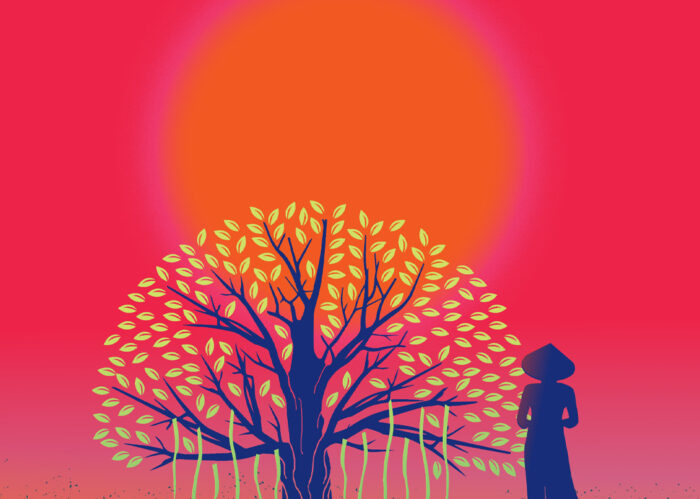O Christmas Tree by Jill McCorkle
 It’s the week between Christmas and New Years. The joy and excitement (and stress) of Christmas are over, but the decorations can still be left alone. For now, at least. The New Year is just around the corner, ready to be filled with resolutions and bold new habits, but right now they only exist as a list and you can savor the last few days of not going to the gym at 6 a.m. or whatever it is you promised yourself on that sticky note on your desk. It’s a good week for reflection, so we asked a few of our authors to tell us what the holidays mean to them. We’re excited to share five essays from them this week. We start today with Jill McCorkle.
It’s the week between Christmas and New Years. The joy and excitement (and stress) of Christmas are over, but the decorations can still be left alone. For now, at least. The New Year is just around the corner, ready to be filled with resolutions and bold new habits, but right now they only exist as a list and you can savor the last few days of not going to the gym at 6 a.m. or whatever it is you promised yourself on that sticky note on your desk. It’s a good week for reflection, so we asked a few of our authors to tell us what the holidays mean to them. We’re excited to share five essays from them this week. We start today with Jill McCorkle.
My earliest memories of Christmas are those I don’t even remember–Kodak moments caught in family slides where the big bulb lights distort the print in such a way that all that is visible of my sister and me are our glowing eyes on a background of lights and the strands of silver icicles. There are many such moments to follow of course and many tree versions, and yet, I never let go of the colorful bulbs and thin strands of silver. I think once artificial trees became available, we had one, and I was always so envious of the friends with real trees, especially flocked trees, especially the year one friend’s family had a pink flocked tree. First came the artificial tree and then the wave of all white lights. Then came those red satin balls. This would have been the same era when kitchen appliances were avocado green and harvest gold, people raked their carpet and Pintos backfired on every corner. My mother liked for those balls to hang in a uniform pattern and then to weave gold tinsel round and round equidistant from the balls. I could respect this, this need for order and symmetry and the great time and pain it took to get there, but it wasn’t what I had believed in so early. When I was eight, I decided I wanted my own tree and took a serrated steak knife and a small hatchet out into the woods along the interstate and got a little pine tree for our storage shed which had become my playhouse. I decorated it with silver icicles and cast off ornaments and aimed a flashlight so it looked like it was lit. This ritual continued for many years, satisfying my desire for a tree that was NOT orderly but looked like something that had just sprung from the earth, fresh and surprising. When too old for the playhouse, I decorated a plant in my room and then in college, my roommate and I always had a small tree–whatever we could find–even for that short bit of time during exams. As a grown up, I get a tree and get it up and lit as close to after Thanksgiving as I can. I can’t imagine not having a tree. I hear people talk about not wanting a tree because of the difficulty and hard work of it all and there is no part of my brain that understands this. It hits me the same way it does when I hear people talk about being tortured by writing. Damn. There is definitely a piece missing in that puzzle. I have found that in sad or hard years, I have wanted and needed that Christmas tree even more. The tree serves as a kind of ritual focal point. I like to get up and turn it on before the day begins–colored lights and silver strands–ornaments that have stories and history–glowing in the darkness. It is a time to look at what has been lost or left behind and a time to look ahead to the unknown. There’s something in the glow that makes me nostalgic but also leaves me filled with anticipation. It makes me think over the years and make mental lists of those people I miss, those I plan to write, those I want to thank; making good on such thoughts is always my resolution; some years I do better than others but the process and ritual remains. I realize I’m dangerously getting a little Hallmark here, but I’ll go for broke and say, I love my tree; I love the smell, and the sound of needles dropping onto packages below. I love how every year the tree is different, its weak spot turned to the corner and filled in with extra lights and icicles; its branches determining what ornaments best fit where, kid photos and home made things front and center. Something new always added.I always acknowledge how much I will miss the tree, especially those early mornings, but when January rolls around I am ready to let go and move on and get back to normal. I remove and box the ornaments, then I unplug and remove the lights; when the tree is tossed out into the yard, it’s branches still shining with silver threads, and I sweep up all the needles, I am already thinking of what I might do a little differently the next year–more lights? More icicles? Mainly, I just want more time sitting there in front of it.
 Jill McCorkle is the author of eight previous books, five of which were New York Times Notable books. Two stories in Going Away Shoes were published in The Best American Short Stories. Winner of the New England Book Award, the Dos Passos Prize for Excellence in Literature, and the North Carolina Award for Literature, McCorkle teaches writing at North Carolina State University and lives with her husband in Hillsborough, North Carolina.
Jill McCorkle is the author of eight previous books, five of which were New York Times Notable books. Two stories in Going Away Shoes were published in The Best American Short Stories. Winner of the New England Book Award, the Dos Passos Prize for Excellence in Literature, and the North Carolina Award for Literature, McCorkle teaches writing at North Carolina State University and lives with her husband in Hillsborough, North Carolina.
-
Overall Score
Reader Rating: 0 Votes



